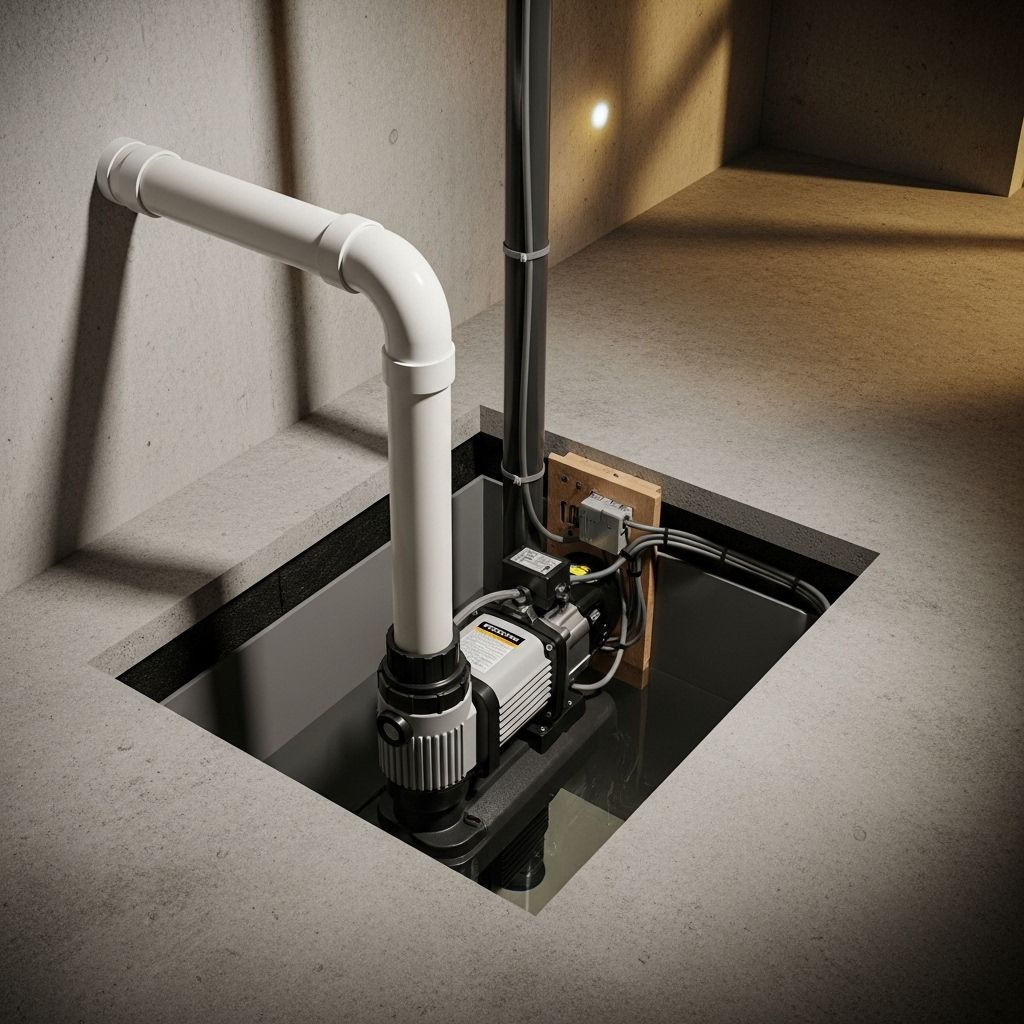Sump Pump Installation Cost In 2025: Comprehensive Guide
Comprehensive guide to sump pump installation costs, influencing factors, unit options, and expert savings tips for homeowners.

Image: HearthJunction Design Team
Sump Pump Installation Cost Guide: Everything Homeowners Need to Know
Waterproofing your basement or crawl space with a sump pump is a smart investment to guard your home’s foundation against costly water damage. Yet, understanding the wide range of installation costs and what impacts them can be tricky. This guide covers national sump pump installation averages, price factors, types of pumps, labor expenses, repair versus replacement, and expert strategies for savings.
What Is a Sump Pump and Why Install One?
A sump pump is a crucial device installed in the lowest part of a home, typically in a basement or crawl space. Its role is to collect and remove excess water from around your foundation, routing it safely away to prevent flooding, mold growth, and structural problems. Sump pumps operate automatically, activating when water in the pit rises to a certain level—making them a practical defense in regions subject to heavy rainfall or high groundwater levels.
Average Sump Pump Installation Costs in 2025
The national average cost to install a sump pump is around $1,400. However, installation can run anywhere from $500 to $4,000, depending on the specifics of your property and project needs.
| Cost Range | Description |
|---|---|
| $500 – $1,200 | Basic installation or replacement in accessible areas |
| $1,200 – $2,500 | Standard installations with moderate difficulty |
| $2,500 – $4,000+ | Complex jobs (concrete basements, inaccessible locations, extensive drainage) |
Simple replacements of an existing sump pump are far less expensive than installing a new system from scratch, which may involve digging pits, adding plumbing, and electrical upgrades.
Factors Affecting Sump Pump Installation Cost
Several elements can raise or lower the price you pay for a new sump pump system:
- Flooring Type: Breaking through concrete floors is costlier ($2,500–$5,000) than digging through dirt ($300–$500 or $5–$10/linear foot).
- Location & Accessibility: Installing in a crawl space or hard-to-reach area adds hundreds of dollars versus an accessible basement.
- Type & Quality of Sump Pump: Heavy-duty, higher-horsepower pumps and those with battery backups cost more.
- Drainage System: Connecting to an existing drainage system is less expensive than installing new pipes and exterior discharge lines.
- Permits & Labor Rates: Local permitting fees and contractor rates can influence your total outlay.
- Electrical Work: Adding circuits or upgrading electrical service increases project costs.
Detailed Breakdown of Sump Pump Costs
- Unit Price: $150–$400 for a standard pump. High-end models or those with built-in backups can reach $500–$1,200.
- Labor: $750–$1,200 for most professional installs. DIY can save on labor but may not be suitable for complex projects.
- Parts & Materials: $50–$350, covering basins, gravel, cement, wiring, and discharge pipes.
- Permits & Inspection Fees: $50–$250 depending on local codes.
- Total Typical Cost (DIY): $350–$450 (not including extensive electrical or drainage work).
Types of Sump Pumps and Their Cost Impact
The two primary types of sump pumps are submersible and pedestal models. There are also backup and specialty options to consider.
| Type | Description | Cost Range |
|---|---|---|
| Submersible | Installed inside the sump pit; quiet, effective, best for basements | $100–$400 (unit only) |
| Pedestal | Motor sits above the pit; easier to maintain, ideal for narrow spaces | $60–$200 (unit only) |
| Battery Backup | Operates during power outages; can be a secondary pump or combo | $150–$350 (add-on) |
| Heavy-Duty/Brass | For high-volume or commercial use | $250–$1,200 (unit only) |
Choosing a reliable, high-capacity pump protects against flooding and minimizes future replacement costs.
Labor Costs: Professional vs. DIY Sump Pump Installation
The decision to hire a professional plumber or contractor affects your final price:
- Professional Installation: $750–$1,200 for labor is standard but can rise if extensive excavation, plumbing, or electrical work is needed.
- DIY Installation: Labor can cost as little as $50–$150 if simply replacing an existing pump in an accessible location. Full installations—digging pits, running discharge piping, and wiring—require significant time and know-how.
Many choose professional installation for peace of mind, especially when dealing with electrical wiring, sump basin excavation, drainage, or local code requirements.
Repair vs. Replace: Deciding What’s Best for Your Sump Pump
Wondering whether to repair or replace your aging sump pump?
- Repair Costs: Average $300–$750, but can reach $1,000+ for major problems.
- Replacement: May be more cost-effective if the pump is old, out of warranty, or has frequent breakdowns. New models offer improved efficiency and reliability.
- When to Replace: If the pump is older than 7–10 years, is noisy, frequently fails, or can’t keep up with water volume, replacement is usually the better option.
Weigh potential future repair costs against the investment in a new, efficient system.
How to Save on Sump Pump Installation
Protecting your home from water damage is critical, but there are several ways to keep costs under control:
- Get Multiple Quotes: Obtain bids from several local pros to compare pricing, warranties, and service quality.
- Bundle Projects: Combine sump pump installation with other plumbing or waterproofing work to save on labor.
- Choose the Right Pump: Don’t overpay for industrial-grade units if your basement has a typical water volume.
- DIY What You Can: Simple tasks like pit excavation or electrical wiring (if qualified) can trim the bill.
- Maintain Regularly: Clean pits and test pumps annually to extend their lifespan and prevent emergency replacements.
Professional vs. DIY Installation: Pros and Cons
| Professional Installation | DIY Installation |
|---|---|
|
|
If you have electrical or structural concerns, or need to break concrete, hire a professional. DIY is best reserved for straightforward swap-outs in accessible basements or crawl spaces.
Should You Invest in a Backup Sump Pump?
Power outages during storms can render a standard sump pump useless. Consider a battery or water-powered backup pump for peace of mind:
- Battery backups run $150–$350 extra and operate when electricity fails.
- Some systems pair a backup pump in the same pit for seamless operation.
- Backup pumps boost the system’s reliability, especially in flood-prone areas.
Frequently Asked Questions (FAQs) About Sump Pump Costs
How much does it cost to install a sump pump in 2025?
The national average is $1,400, with the range spanning $500 to $4,000+ depending on complexity, type of pump, and labor required.
Is it cheaper to replace a sump pump than install a new one?
Yes, replacing an existing pump typically costs less than installing a new system, which requires excavation and new plumbing. Replacement can be as low as $50–$350, plus the cost of the new pump.
How long do sump pumps last?
Most last 7–10 years with regular maintenance. Frequent cycling, debris, and electrical surges can shorten lifespan.
Should I get a battery backup sump pump?
In areas prone to power outages or heavy storms, a battery backup offers valuable protection and peace of mind for a modest added cost.
Can I install a sump pump myself?
Experienced DIYers can replace accessible pumps, but new installations involving excavation, electrical, or plumbing work are best left to professionals.
Expert Tips for Maintaining and Maximizing Sump Pump Value
- Test your pump every few months by pouring water into the pit and ensuring automatic operation.
- Clean the sump pit and pump inlet regularly to prevent clogs and reduce wear.
- Check discharge piping for blockages, especially after heavy storms.
- Replace backup batteries every 2–3 years for reliability.
Conclusion
Installing a sump pump offers crucial protection for basements and crawl spaces, safeguarding your home’s foundation and contents against water damage. With national costs averaging around $1,400 but ranging widely based on unit type, labor, and specific site conditions, it’s vital to understand your options and the variables influencing price. Careful selection, regular maintenance, and seeking multiple quotes will help you enjoy long-term savings and resilient home protection.
References
- https://www.thisoldhouse.com/plumbing/reviews/sump-pump-cost
- https://www.thisoldhouse.com/plumbing/reviews/best-sump-pump
- https://home.costhelper.com/sump-pump.html
- https://www.centralhtg.com/blog/when-to-repair-vs-replace-your-aging-sump-pump-a-guide
- https://www.bobvila.com/articles/sump-pump-cost/
Read full bio of Anjali Sayee










